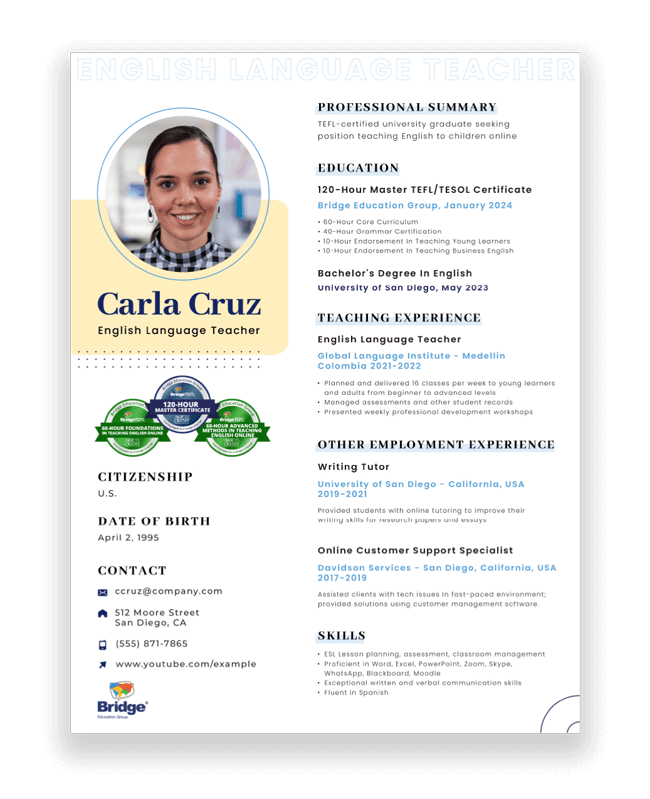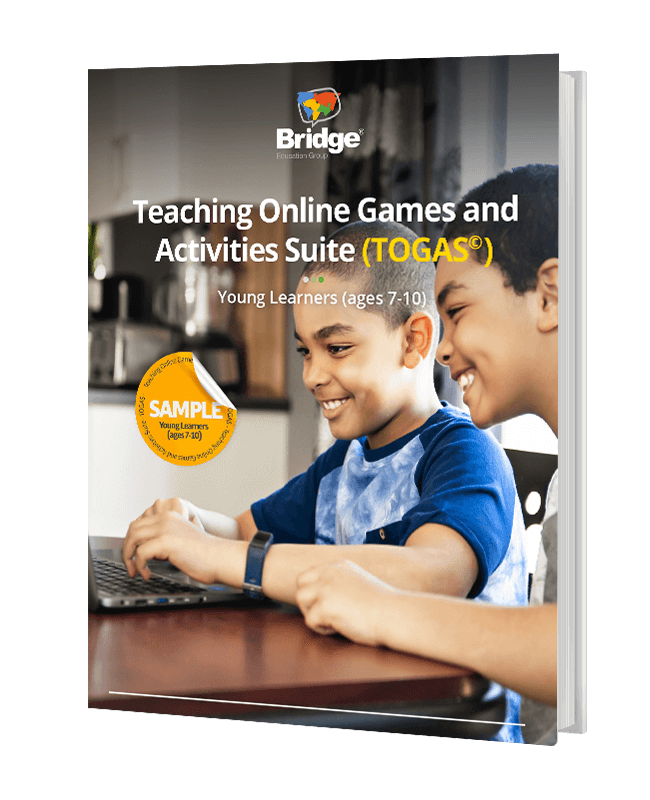TEFL/TESOL eBooks
Download free TEFL/TESOL eBooks to inform and inspire you! Bridge experts and experienced English teachers around the world share insights into learning methodologies, professional development, and more in these practical guides. Discover the best ELT resources the industry has to offer, and learn about games, activities, and tools that can enhance your classes, whether you’re teaching English online or in person. Use these TEFL eBooks to take the next step in your TEFL career and become a more effective English language teacher for your students.
Our Latest eBooks
AI-Powered Tools to Support Student Speaking Practice
DOWNLOADThis practical guide introduces top AI-powered tools English teachers can use to support learners’ speaking practice outside the classroom.
AI-Powered Content Creation and Lesson Planning Resources
DOWNLOADUnlock the power of AI with innovative tools that simplify lesson planning, create high-quality materials, and save you hours of work!
Teaching English as a Lingua Franca: Teaching Business English as a Corporate Language Trainer
DOWNLOADDiscover the global role of English as a lingua franca and learn about Bridge’s innovative approach to Business English training for professionals.
Explore all eBooks
Careers in TEFL
Discover the essentials of launching and advancing your TEFL career, whether you’re teaching online, abroad, or specializing in fields like business English. Explore tips for landing your dream job, destination insights, and strategies for self-guided professional development.
Teaching English as a Lingua Franca: Teaching Business English as a Corporate Language Trainer
DOWNLOADDiscover the global role of English as a lingua franca and learn about Bridge’s innovative approach to Business English training for professionals.
Sample English Teacher Resume
DOWNLOADCrafting the perfect TEFL resume doesn’t have to be a challenge. Our sample resume highlights key skills and experience to impress employers.
Teaching English as a Foreign Language: From Getting Started to Landing a TEFL Job
DOWNLOADThis eBook offers a comprehensive guide to launching your TEFL career, from understanding certification to navigating job markets and preparing for interviews, providing key tips and strategies for teaching English globally.
How to Teach English Online
DOWNLOADOpportunities abound in the online teaching English as a foreign language (TEFL) profession. Get the information you need on requirements, job opportunities, pay ranges, and more in our comprehensive guide to how to teach English online.
Teaching English to Adults
DOWNLOADMany opportunities exist to teach English to adults. This guide provides insights into teaching adult learners, including specialized niches and classroom strategies, as well as advice for finding a job in person or online.
Teach English Abroad Destination Guide
DOWNLOADWhen it comes to teaching English abroad, you’ve got a world of options. This eBook provides detailed insights into how to teach in 18 countries in regions around the world, plus includes insider information from experienced teachers.
Self-Guided Professional Development in ELT
DOWNLOADLearn about the importance of continuing professional development (CPD), discover CPD opportunities for ESL teachers, and map out your unique professional development path so you can take charge of your career.
ELT Resource Guides
Enhance your teaching toolkit with expert guides on lesson planning resources, testing, and using LMS platforms. These resources are designed to support English language teachers in delivering innovative and effective instruction.
AI-Powered Tools to Support Student Speaking Practice
DOWNLOADThis practical guide introduces top AI-powered tools English teachers can use to support learners’ speaking practice outside the classroom.
AI-Powered Content Creation and Lesson Planning Resources
DOWNLOADUnlock the power of AI with innovative tools that simplify lesson planning, create high-quality materials, and save you hours of work!
Testing in English Language Learning
DOWNLOADExplore our comprehensive guide to English language tests, their range of purposes for test takers, teachers, and employers as well as our curated collection of dynamic and effective English language test prep resources!
The Teacherpreneur’s Guide to LMS and Learning Platforms
DOWNLOADAnalyze 12 learning platforms for online independent tutors, tutoring businesses, and language schools using nine criteria that will guide you in choosing the best platform for your online business.
Business English: Empowering Teachers With Dynamic Resources
DOWNLOADFrom podcasts and videos to digital and print textbook training, help your Business English students reach their learning goals with this curated collection of Business English teaching resources.
The ESL Teacher’s Guide to Lesson Planning Resources
DOWNLOADThe need for quality ESL/EFL lesson plans has inspired growth in the ready-made lesson plan industry. Compare lesson planning companies to see where you can find the resources that will benefit your students the most.
TEFL Activities & Games
Engage learners of all ages with creative games and activities designed to make English language learning fun and interactive. These resources are perfect for inspiring participation and building key language skills.
Teaching Online Games and Activities – Very Young Learners
DOWNLOADDownload this eBook for a sampling of the attention-grabbing games for preschool students (ages 4-6) from our Games and Activities for the Online Classroom (Very Young Learners) Micro-credential Course.
Teaching Online Games and Activities – Young Learners
DOWNLOADDo you teach English online to young learners ages 7-10 and need new ideas? Here’s a sampling of fun games from our Games & Activities for the Online Classroom (Young Learners) Micro-credential Course.
Teaching Online Games and Activities – Teenagers
DOWNLOADOnline games for teaching teens need to be age-appropriate, entertaining, and educational. These ideas are straight from our Games and Activities for the Online Classroom (Teenagers) Micro-credential Course.
Teaching Online Games and Activities – Adults
DOWNLOADESL games aren’t just for kids – they help adult students practice the language in context and build confidence. Check out games from our Games and Activities for the Online Classroom (Adults) Micro-credential Course.
Pedagogy
Explore foundational and cutting-edge teaching strategies to elevate your ESL/EFL instruction. From methodologies and conversational teaching to integrating 21st-century skills and AI, these guides offer valuable insights for effective classroom practices.
Teaching English Conversation
DOWNLOADTeaching conversational English focuses on real-life communication. This infographic offers tips, strategies, and discussion ideas to help students build fluency and confidence.
Combining the CEFR and GSE in English Language Teaching
DOWNLOADLearn how combining the CEFR and GSE in English language teaching can provide targeted instructional strategies to fast-track your students’ learning progress.
3 Steps to Create a Lesson Plan Using AI
DOWNLOADLearn the three steps needed to create a great ESL/EFL lesson plan using AI.
Teaching English Learners: Popular ESL Learning Methodologies
DOWNLOADIdentifying the best learning methods to meet the needs of your students doesn’t need to be difficult. From the Direct Method to TPRS, we’ll break down eight ESL methodologies and provide practical example activities.
Guide to Teaching 21st-Century Skills in the ESL/EFL Classroom
DOWNLOADLearn what 21st-century skills are and why teachers should incorporate them into the English language classroom. Get strategies for making these transferable skills a part of every ESL lesson!
Teaching English Independently
Learn how to take charge of your teaching career with resources on becoming an independent English teacher. From building a student portfolio to managing your business, these guides help you thrive as a teacherpreneur.
Three Ways to Be an Independent Online English Teacher
DOWNLOADExplore three ways to build an independent teaching career and the steps to follow each path.
Teacherpreneur Playbook: How to Build and Manage Your Own Student Portfolio
DOWNLOADReady to take charge of your own teaching schedule, work location, and hourly class rates? Download this eBook for a play-by-play guide to identifying your business goals, finding your niche, and planning your future as a Teacherpreneur.
How to Become an Independent English Teacher
DOWNLOADIndependent English teachers come in many forms, from those freelance teaching with companies to those working through marketplaces to teacherpreneurs running their own businesses. Learn how to become your own boss!
























